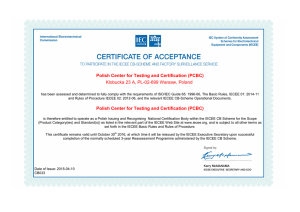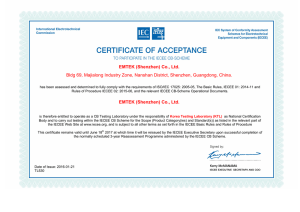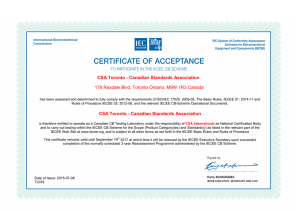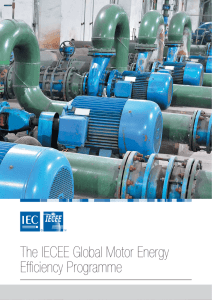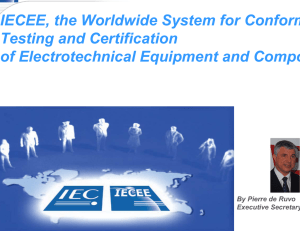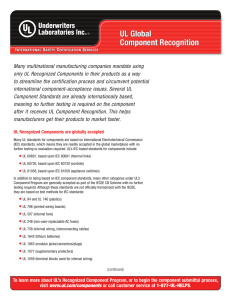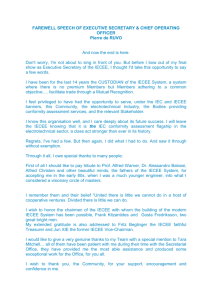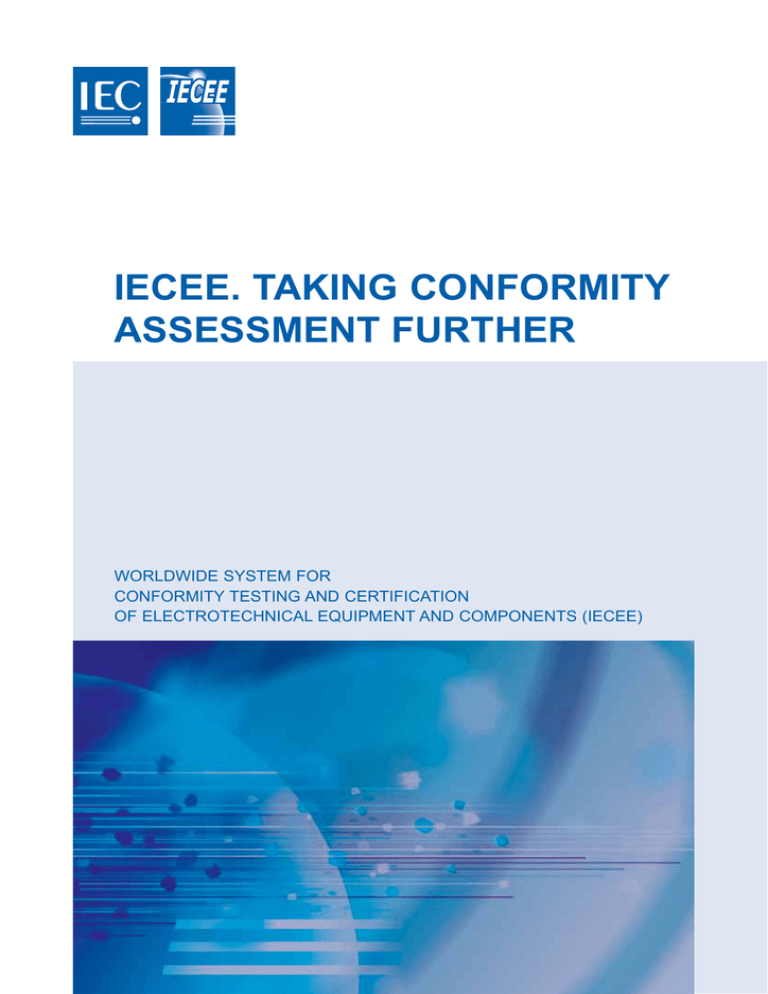
IECEE. TAKING CONFORMITY
ASSESSMENT FURTHER
WORLDWIDE SYSTEM FOR
CONFORMITY TESTING AND CERTIFICATION
OF ELECTROTECHNICAL EQUIPMENT AND COMPONENTS (IECEE)
ABOUT CONFORMITY ASSESSMENT
The IECEE offers the potential of one test (based on a
The first is safety: governments want to protect the
standard), one certification (to prove the conformity),
population, particularly consumers and workers in high
and one or more marks as appropriate (the visual
risk areas.
symbol for proof of conformity). The IEC’s worldwide
conformity assessment systems cover all scenarios:
The second is performance: buyers (usually
the one-stop shop.
wholesale) want to ensure quality and safety of
products.
The IEC sees three main underlying reasons for
carrying out conformity assessment.
The third is interoperability: other manufacturers
want to know that their product will work correctly with
the one being assessed.
3
Conformity assessment
benefits for many players:
produces
tangible
product or system again. This means that products can
For governments, it helps reduce trade barriers
caused by different certification criteria in various
countries and helps countries meet their obligations as
stipulated
in
the
World
others all over the world without the need to assess the
Trade
Organization’s
Agreement on Technical Barriers to Trade. It is
important to understand that conformity assessment
covers the regulated and non-regulated world.
get to market more quickly and with less expense (that
is, fewer tests), and that products can have access to
a larger market (potentially the entire world).
Conformity assessment also provides assurance that
the goods being purchased will perform to expectations
and be safe to use.
For industry, it reduces delays and costs of multiple
testing and approval since a product or process can be
certified once and that certification can be accepted by
www.iecee.org
4
The fundamental principle of conformity
assessment is to determine whether a product
adheres to a standard.
There are three types of assessment:
and impartiality. Having a worldwide system to
recognise certificates provides the greatest gains. The
IECEE is a system for mutual recognition of certificates
of conformity and also a tool to access the worldwide
markets directly, when National Authorities and
First party, or the seller: the manufacturer does
its testing of its own products in its in-house test
laboratory and provides a supplier’s declaration of
conformity.
Regulators, retailers, buyers and vendors accept
the CB Test Certificate and associated Test Report.
Mutual recognition rests on the confidence built
through having the competence of each member
laboratory and certifier assessed by its member peers.
Second party, or the buyer: the company buying the
product does its own testing.
Openness is an important aspect of the IECEE
systems. For users, the systems are open to any
Third party, neither seller nor buyer: an independent
party carries out the test.
manufacturer anywhere in the world. Manufacturers
can be located anywhere in the world and still benefit
from using the CB Scheme, even in non-IEC member
IECEE conformity assessment offers third party
countries.
services as the best means of providing independency
5
THE IECEE
What is the IECEE?
faster, whilst reducing financial costs. With
increasing market demand, the IECEE is expanding
The IECEE is a multilateral certification system
its activities into new fields.
based on standards prepared by the International
Electrotechnical Commission. The abbreviation
stands for IEC System for Conformity Testing and
Certification of Electrotechnical Equipment and
Components. Its members use the principle of
mutual recognition (reciprocal acceptance) of test
results to obtain certification or approval at national
levels around the world.
The IECEE's multilateral conformity assessment
schemes, based on IEC International Standards, are
truly global in concept and in practice, thereby
As the world of electrotechnology is exploding,
people are relying daily on products whose design
and
construction
they
do
not
understand.
Reassurance is needed for such users and
consumers that their product is reliable and will meet
their expectations in terms of performance, safety,
durability and other criteria.
How can the industrial user and the final consumer
be sure that the product they buy conforms to the
criteria of an IEC Standard?
reducing trade barriers caused by different
certification criteria in different countries and helping
industry to access new markets. Removing the
significant delays and costs of multiple testing and
approval allows industry to market its products
6
The IECEE Schemes exist to provide just this
reassurance.
Using IEC Standards for certification at the national
Quality and performance are also built into these
level ensures that a certified product has been
products because they are based on IEC Standards.
manufactured and type-tested to well-established
International Standards. The end user can be sure
Why should l be interested?
that the product complies with the requirements of
The IECEE saves you both time and money –
the relevant international standard in all respects.
reducing overall manufacturing costs. Different
certification requirements in various countries mean
What does it do?
that manufacturers have to test their electrical
in
equipment over and over each time they wish to
electrotechnical equipment and components easier
export to a new market. Each test takes time and
and less costly by reducing technical barriers to
costs money. Because the IECEE operates
trade. A typical example of a technical barrier is
according to the principle of mutual recognition,
differing certification requirements across various
type-testing only has to be done once.
The
IECEE
makes
international
trade
countries. IEC International Standards and the
IECEE help to eliminate these technical barriers
because electrical equipment manufactured to IEC
Standards and tested within the IECEE system
ensure the same high level of safety no matter
where these products are made and tested.
7
WHAT KIND OF EQUIPMENT ARE WE TALKING ABOUT?
There are 19 categories of electrical equipment covered by the IECEE:
8
BATT
Batteries
HOUS
Household and similar
equipment
CABL
Cables and Cords
INST
Installation accessories and
connection devices
CAP
Capacitors as components
LITE
Luminaires
CONT
Switches for appliances and
automatic controls for electrical
household appliances
MEAS
Measuring instruments
EMC
Electromagnetic Compatibilitiy
MED
Electrical equipment for
medical use
MISC
Miscellaneous
SAFE
Safety transformers and
similar equipment
OFF
IT and office equipment
TOOL
Portable tools
POW
Low voltage, high power
switching equipment
TOYS
Electric Toys
PROT
Installation protective
equipment
TRON
Electronics, entertainment
PV
Photovoltaics
You can find a full list of categories, products
and the IEC Standards that relate to them on
our website (www.iecee.org).
9
THE STRUCTURE OF THE IECEE
The IECEE governing structure rests with the
The Board of Appeals has the responsibility to
Certification Management Committee supported by
arbitrate disputes and formal complaints filed by
the Committee of Testing Laboratories (CTL) for
members and stakeholders. The Policy & Strategy
technical issues, by the Assessment & Certification
forum is an appointed group of Senior Industry and
Advisory Group (ACAG) for the Peer Assessment
Certification experts that ensures the IECEE is
Programme
always up-to-date with the current and future market
and
by
the
Factory
Inspection
Committee (FIC) for the Factory Audit/Inspection.
trends.
Board of
Appeals
Factory
Inspection
Committee
Policy &
Strategy
Forum
(FIC)
IECEE
CERTIFICATION
MANAGEMENT
COMMITTEE
(CMC)
10
Committee of
Testing
Laboratories
Assessment &
Certification
Advisory Group
(CTL)
(ACAG)
HOW DO THE IECEE SCHEMES WORK?
Take the example of a personal computer (PC)
Certification Bodies will issue their certification mark
manufactured in Japan. The manufacturer makes an
without re-testing the personal computer because
application to a Japanese IECEE Certification Body
they recognise the Japanese NCB as one of their
seeking a CB* Test Certificate and its associated
peers in the IECEE and have full confidence in the
Test Report. The NCBs** associated laboratory will
testing and assessment that have already been
carry out the relevant tests based on the relevant
done. The Japanese manufacturer may now affix the
IEC Standards and issue a Test Report that will be
national mark of conformity of the American,
reviewed and validated by the Certification Body
Brazilian and German bodies to the PC and is free
who will subsequently issue a CB Test Certificate.
to export it to these countries.
Wishing to sell the PC in the USA, Brazil, and in
Germany, for example, the manufacturer sends the
CB Test Certificate and associated Test Report to the
IECEE Certification Bodies located in these
countries. After an administrative review of the
CB Test Certificate and Test Report the relevant
* CB stands for Certification Body.
** NCB stands for National Certification Body.
11
12
How do these bodies participate?
You can find a full list of IECEE members, NCBs and
associated testing laboratories on our website:
The IECEE is represented worldwide and qualifies
www.iecee.org
the NCBs within each country that will be
responsible for recognising and issuing CB Test
Reports and Certificates. Membership in the IECEE
What if I'm in a country where the IECEE does
not exist?
is open to any certification body anywhere in the
No problem at all. For testing and certification, you
world.
are free to choose any NCB in the world to send your
Many NCBs in countries where the IECEE does not
product/equipment to.
exist will accept CB Test Certificates and CB Test
Reports.
COUNTRIES PARTICIPATING IN THE MOST SUCCESSFUL
WORLDWIDE CONFORMITY ASSESSMENT SCHEME... AND MORE TO COME
ARGENTINA
FRANCE
MEXICO
SLOVENIA
AUSTRALIA
GERMANY
NETHERLANDS
SOUTH AFRICA
AUSTRIA
GREECE
NEW ZEALAND
SPAIN
BELARUS
HUNGARY
NORWAY
SWEDEN
BELGIUM
INDIA
POLAND
SWITZERLAND
BRAZIL
INDONESIA
PORTUGAL
THAILAND
BULGARIA
IRELAND
ROMANIA
TURKEY
CANADA
ISRAEL
UKRAINE
CHINA
ITALY
RUSSIAN
FEDERATION
CROATIA
JAPAN
CZECH REPUBLIC
SAUDI ARABIA
UNITED ARAB
EMIRATES
KENYA
SERBIA, REP. OF
UNITED KINGDOM
DENMARK
KOREA, REP. OF
SINGAPORE
URUGUAY
FINLAND
MALAYSIA
SLOVAKIA
USA
13
MUTUAL RECOGNITION OF CB TEST CERTIFICATES
BY THE MEMBERS
The IECEE Processes
The CB Scheme is applicable to Electrotechnical
specimens of the product have successfully passed
Equipment and Components primarily intended for use
tests to show compliance with the requirements of the
in homes, offices, workshops, healthcare facilities and
relevant IEC Standard. A supplementary report providing
similar locations.
evidence of compliance with declared national
differences in order to obtain national certification or
The CB Scheme is based on the use of CB Test
approval may also be attached to the CB Test Report.
Certificates which provide evidence that representative
Applicant
Application to the NCB A
NCB A processes application
and assigns CBTL* to carry out
the testing
NCB A issues CB Test Certificate with Testing Report
Applicant receives CB Test Certificate and associated Test Report
CB Test Certificate + Test Report
Applicant sends documents to NCB B/C/D/n...
CBTL A completes testing to the IEC Standard +
National Difference
CBTL A issues Test Report
NCB A reviews and validates the
Test Report
* CBTL stands for CB Testing Laboratory
14
NCB B/C/D/n.. processes the
received documents and grants its
certification mark(s)
Applicant is granted with NCB B/C/D/n...
certification mark within 15 working days
CB Scheme direct acceptance by the market place
The success of the IECEE CB Scheme is also due to
As a matter of fact, CB Test
Certificate and
its popularity in the various worldwide marketplace
Test Reports are commonly accepted by National
where CB Test Certificates and Test Reports are
Regulatory Authorities, retailers, buyers and vendors
considered as proof of compliance with the safety
for accessing the relevant markets directly.
requirements according to the IEC Standards.
Applicant requests certificate for their product
Application to the NCB
NCB processes application and
assigns a CBTL to carry out
the testing
CBTL completes testing to the
IEC Standard + National Difference
Applicant receives CB Test Certificate and
associated Test Report
CB Test Certificate + Test Report
Applicant addresses CB Test Certificate + Test Report to
retailers, buyers, vendors and National Regulatory Authorites
CBTL issues Test Report
NCB receives and validates the
Test Report
NCB issues CB Test Certificate
Retailers, buyers, vendors and
National Regulatory Authorites purchase/accept
the CBTC/ CBTR to allow access to their
respective market
Product can be sold in the relevant market
15
IECEE CB-FCS Process
The IECEE CB Full Certification Scheme (CB-FCS) is
Use of CB-FCS to its fullest extent promotes
an extension of the IECEE CB Scheme as it also
the exchange of information necessary and assists
includes Factory Audit/Inspection and re-testing which
manufacturers around the world to obtain certification
ensures that the overall production line is consistently
or approval at a national level in one or multiple
compliant with the initial testing/certification.
countries and regions.
Applicant
Application to the NCB A
NCB A processes application
and assigns Factory Inspection
Department to carry out the
inspection
NCB A processes application
and assigns CBTL to carry out
the testing
CBTL A complete testing to the IEC Standard +
National Difference
CBTL A issues Test Report
NCB A reviews and
validates the Test Report:
Test result positive?
Factory Inspection Department completes inspection
to the IEC Standard + National Difference
Factory Inspection Department issues Factory
Inspection Report
NCB A reviews and
validates the Factory Inspection Report:
Test result positive?
NCB A issues CB Test Certificate with
Testing Report and Factory Inspection Report
Applicant receives CB Test Certificate and
associated Test Report + Factory Inspection Report
CB Test Certificate + Test Report +
Factory Inspection Report
Applicant sends documents to NCB B/C/D/n...
NCB B/C/D/n.. processes
the received documents and grants
its certification mark(s)
Applicant is granted with NCB B/C/D/n..
certification mark(s) within 15 working days
16
IECEE CB-FCS direct acceptance by the market place
The
Conformity
Assessment
Certificate
and
the Conformity Assessment Report, being proof of
National Regulatory Authorities, retailers, buyers and
vendors to access the relevant markets directly.
compliance with the safety requirements according to
the IEC Standards, are commonly accepted by
Applicant
Application to the NCB A
NCB A processes application
and assigns CBTL to carry out
the testing
CBTL A completes testing to the IEC Standard +
National Difference
NCB A processes application
and assigns Factory Inspection
Department to carry out the
inspection
Factory Inspection Department completes inspection
to the IEC Standard + National Difference
CBTL A issues Test Report
Factory Inspection Department issues Factory
Inspection Report
NCB A reviews and
validates the Test Report:
Test result positive?
NCB A reviews and
validates the Factory Inspection Report:
Test result positive?
NCB A issues CB Test Certificate with
Testing Report and Factory Inspection Report
Applicant receives CB Test Certificate and
associated Test Report + Factory Inspection Report
CB Test Certificate + Test Report +
Factory Inspection Report
Applicant addresses CB Test Certificate + Test Report +
Factory Inspection Report to retailers, buyers, vendors
and National Regulatory Authorities
Retailers, buyers, vendors and
National Regulatory Authorities accept the
CBTC/CBTR to purchase/allow access to
their respective market
Product can be sold in the relevant market
17
YESTERDAY, TODAY AND TOMORROW... THE IECEE
IECEE Statistics
The spectacular growth of the number of CB Test Certificates shows clearly that the CB Scheme is properly
answering the market needs.
NUMBER OF IECEE CERTIFICATES ISSUED FROM 1996 TO 2006
50278
50000
47500
45000
42500
40000
37500
35000
32500
30000
27500
25000
22500
20000
17500
15000
12500
10000
7500
5000
2500
0
40817
36465
34111
27685
24259
19597
15893
12175
7794
1996
18
9825
1997
1998
1999
2000
2001
2002
2003
2004
2005
2006
19
Future development
of the IECEE
The IECEE is exploring developments in other
fields of activity with new technologies to offer the
market place services in SMART Home Equipment,
Intelligent Sensors, Renewable Energy Devices,
Supply Chain Management, Functional Safety,
Energy Efficiency, Wireless Communication WiFi®
and Bluetooth® and Machine to Machine
Interoperability.
20
Globalising Conformity
Assessment
Because Globalisation and Competition are leading
to rapid changes, technical barriers to trade remain
a serious concern and the industry is anxious about
time to market, the shortening life-cycle of products
and the need to reduce cost.
The CB Schemes offer the true “passport” for the
needs of different countries.
The CB Schemes answer the market needs to have a
Test Certificate tailored to be recognised worldwide.
The CB Schemes prove that certification and testing
costs can be reduced.
21
IECEE.
TAKING CONFORMITY ASSESSMENT FURTHER
Please feel free to contact the IECEE Secretariat:
Mr Pierre de Ruvo
Executive Secretary IECEE
Email: pro@iec.ch
Tel: +41 22 919 02 07
IECEE Secretariat's main areas of activity
22
Ms Cecilie Ingels Finstad
Assistant
Email: cfi@iec.ch
Tel: +41 22 919 02 23
CB Bulletin
Contact and Certificate changes
Finance
Manufacturer’s Testing Laboratories (MTLs)
Marketing and promotion
Test Report Forms (TRFs)
Ms Tara Mitchell
Assistant and Webpublisher
Email: tsm@iec.ch
Tel: +41 22 919 02 52
CBTC On-Line System
CMC and other IECEE meetings/Workshops
CTL updates
Factory Inspection Committee (FIC)
General enquiries
IECEE Website
Ms Katharine Pearson
Assistant
Email: kpe@iec.ch
Tel: +41 22 919 02 47
Assessment & Certification Advisory Group (ACAG)
Assessor registration
CAB-ILAC / CAB-IAF meetings
Peer Assessment (applications, assessments)
Peer Assessment Training Courses
Proficiency Testing Programmes (PTPs)
WORLDWIDE SYSTEM FOR
CONFORMITY TESTING AND CERTIFICATION
OF ELECTROTECHNICAL EQUIPMENT AND COMPONENTS (IECEE)
c/o IEC Central Office
3, rue de Varembé
P.O. Box 131
CH 1211 Geneva 20
Switzerland
IECEE. Taking Conformity Assessment Further
Copyright © 2008 IEC-IECEE. All rights reserved.
2008-01 - First edition
Tel: +41 22 919 02 52
Fax: +41 22 919 03 00
www.iecee.org

